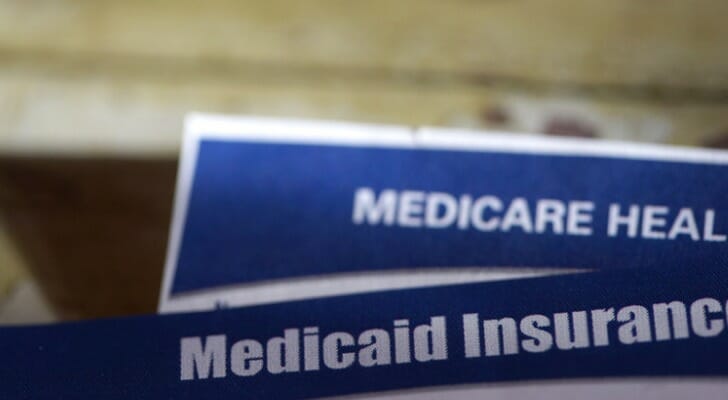Medicare and Medicaid are two health insurance programs run by the government. Despite their similar names, they differ in some key respects. Medicare is available to most Americans over the age of 65, whereas Medicaid is exclusive to lower-income individuals and some disabled people. Another big difference is that the specifics of Medicaid vary from state to state, whereas Medicare is the same nationwide. Your usage of one, both or neither of these programs could have a big impact on your retirement budget, so it pays to know how each works. Consider working with a financial advisor so your selection of healthcare will fit your needs and goals.
What Is Medicare?
Medicare is a health insurance program run by the federal government for all Americans age 65 and older. People younger than 65 who have certain qualifying illnesses and disabilities can also qualify for Medicare. As of September 2022, approximately 65.1 million individuals were enrolled in Medicare, an increase of 160,823 since the last report. Of those, some 35 million were enrolled in Original Medicare and some 30 million were enrolled in Medicare Advantage or other healthcare plans.
This program comes in four parts:
Medicare Part A & Part B (Original Medicare)
Medicare Part A covers in-facility healthcare. This encompasses stays in the hospital, hospice services and specialized nursing care. It can also cover some in-home services.
Medicare Part B covers the bulk of medical care. It applies to doctor appointments, outpatient services, medical supplies, preventative medicine and ambulance services.
Most Americans become eligible for Part A once they begin receiving Social Security retirement benefits. Your eligibility is also contingent upon being either a U.S. citizen or a legal permanent resident for at least five years.
If you’re eligible for premium-free Medicare Part A coverage, you’ll also be eligible for Part B. Those who pay a premium for Part A will only gain eligibility for Part B if they are 65 or older and are either a U.S. citizen or a permanent resident for at least five years. Medicare Part B, however, includes its own premium.
Medicare Part D
Part D covers benefits for prescription drugs. Individuals, typically for additional cost, can enroll in specific Medicare Part D plans.
The requirements for joining Medicare Part D are simple. First and foremost, you need to have either Medicare Part A or B. Next, you must live in the service area of a plan that provides coverage for prescription drugs.
Medicare Advantage (Part C)
Medicare Advantage, also known as Medicare Part C, is offered through private insurance companies rather than via the federal government. To be part of this program, these outside insurance companies must gain approval.
Under these plans, the government pays a set fee every month to a private insurance company, which in turn provides coverage to the enrollee. In some cases, you main gain access to extra coverage for vision, dental and more. According to the Kaiser Family Foundation, around one-third of all Medicare beneficiaries in 2018 are part of the Part C program.
Similar to Medicare Part D, Medicare Advantage requires that enrollees already have Part A and Part B coverage. To maintain eligibility, you must live in the service area of the plan you want to join.
What Is Medicaid?

Medicaid is a government-sponsored health insurance program for Americans in need. It is jointly run by the federal government and individual state governments. As of November 2022 there were 84,815,742 people enrolled in Medicaid, an increase of 440,928 from October 2022, according to the Centers for Medicare and Medicaid Services.
The federal government, through the Department of Health and Human Services, oversees Medicaid at a national level. Each state has an agency which implements the program within that state. That means that the specifics of Medicaid enrollment, eligibility and coverage differ from state to state.
What Medicaid Covers
Coverage under Medicaid is a combination of federal requirements and state policy. Mandatory benefits include inpatient hospital services, rural health clinic services and doctor’s visits. Optional benefits vary on a state-to-state basis and include prescription drug coverage, eyeglasses and dental services.
For eligible services, Medicaid operates like a standard health insurance program. Depending on the state, it might require a copayment or monthly premium based on the individual’s modified adjusted gross income (MAGI). For example, Arkansas charges individuals who make more than 100% of the federal poverty level a monthly premium capped at 2% of their income.
Medicaid Eligibility
Most often, eligibility for Medicaid is based on financial need as determined by MAGI. Each state sets its own standards for income level which qualifies someone for Medicaid coverage. This is often expressed in terms of the federal poverty level. For example, a cutoff at 120% would include someone who makes up to 120% of the federal poverty level in MAGI.
Under the Affordable Care Act, states can extend coverage to everyone who earns up to 138% of the federal poverty level. The federal government pays for this expansion of services.
Acts of Congress have created a list of “Mandatory Eligibility Groups,” which are categories of people who must have access to Medicaid coverage. People with certain conditions, such as blindness or permanent disability, can qualify for Medicaid coverage, regardless of income. For a full list of each state’s qualifications, check out Medicaid’s website.
How Do Medicare and Medicaid Compare?

Medicare and Medicaid were both created in 1965 when Lyndon B. Johnson’s administration expanded Social Security. The original purpose of each program was to combat poverty among different segments of the population. They are similar in many senses, but there are a few key distinctions to note.
Cost-Sharing
Medicare can sometimes involve significant cost-sharing, such as monthly premiums, co-pays and deductibles. This depends on many factors, including coverage type (Part A, B, C or D), the extent of health care consumption and how many quarters someone spent paying Medicare taxes during their working years.
In particular, Medicare costs involve a factor known as “lifetime reserve days.” These come to the rescue to help pay for long-term hospital stays. Original Medicare covers you for as many as 90 days of inpatient hospital care. Should you surpass this, Medicare will begin eating into your lifetime reserve days.
Each enrollee has 60 total reserve days over his or her lifetime. These days do not renew, meaning you can only use them once. For 2023, beneficiaries must pay a coinsurance charge of $400 per day for the 61st through 90th day of a hospitalization, up from $389 in 2022, in a benefit period and $800 per day for lifetime reserve days, up from $778 in 2022.
Medicaid can involve some aspects of cost-sharing depending on the individual state. While many states involve neither premiums nor co-pays, others can require patient contributions, which are typically based on income level. In virtually all cases, Medicaid cost-sharing is minimal, by federal requirement.
Eligibility
All U.S. citizens or permanent residents who have lived in the U.S. for at least five years qualify for Medicare at age 65. Some citizens or residents can qualify if they have certain disabilities or illnesses.
Medicaid eligibility is established on a state-by-state basis. Income is the most common determining factor, although, in some cases, it can be based on disability or illness.
Funding
In order to fund Medicare, the federal government imposes a payroll tax on income earnings. This is in direct contrast to the income tax, which is collected only on qualified earnings.
Every employee in the U.S. pays 1.45% of their income, while their employer pays a matching 1.45%. Self-employed workers pay the entire 2.9% on their earnings. This is part of what’s known as the self-employment tax.
On the other hand, Medicaid receives funding through federal and state appropriations. The federal government makes payments on a share of program costs known as the Federal Medical Assistance Percentage (FMAP). The wealthier the state, the less the federal government will pay to cover its programs. How much each state varies, with state contributions ranging from 20% to 50%.
Tips for Covering Your Retirement Expenses
- From healthcare expenses to dream vacations, retirement is full of expenses that you’ll need to cover without the benefit of a regular paycheck. Put together a prospective retirement budget and then use our retirement calculator to see if your savings are enough to cover those expenses.
- Between saving rates, investing plans and tax issues, there are a lot of factors that go into a sound retirement plan. A financial advisor can help with this. Finding a financial advisor doesn’t have to be hard. SmartAsset’s free tool matches you with up to three vetted financial advisors who serve your area, and you can interview your advisor matches at no cost to decide which one is right for you. If you’re ready to find an advisor who can help you achieve your financial goals, get started now.
Photo credit: ©iStock.com/Kameleon007, ©iStock.com/VeranoVerde, ©iStock.com/dragana991
